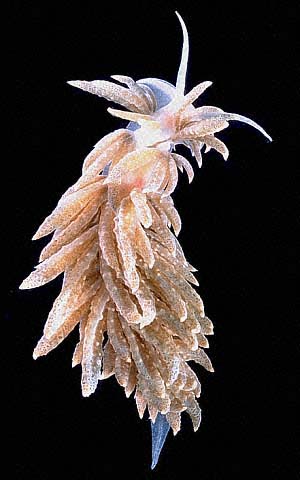
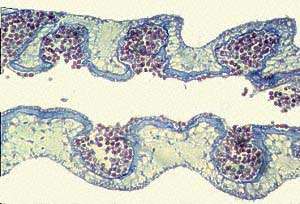
Phyllodesmium crypticum
Rudman, 1981
Order: NUDIBRANCHIA
Suborder: AEOLIDINA
Family: Glaucidae
DISTRIBUTION
Known from tropical eastern Australia, but possibly more widely spread in the western Pacific.
PHOTO
UPPER: Phyllodesmium crypticum Angourie, northern New South Wales, Australia. October 1979. Length 5cm. PHOTO: Bill Rudman.
LOWER: Section through a tentacle of the soft coral Xenia showing the pouches of symbiotic zooxanthellae (stained red). Xenia is the preferred food of Phyllodesmium crypticum.
PHOTO: Bill Rudman.
RELATED TOPIC
As its name suggests, Phyllodesmium crypticum is a very cryptic species, well-camouflaged amongst the colonies of the soft-coral Xenia in which it lives and on which it feeds. This is another of the many species of aeolid which store zooxanthellae from their food, presumably obtaining nourishment when they photosynthesise. The large sacs of zooxanthellae found in the tentacles of Xenia are clearly the source of Phyllodesmium's zooxanthellae.
This species is very similar in appearance to Phyllodesmium hyalinum, another species found in association with the soft coral Xenia. See Phyllodesmium hyalinum, for distinguishing features of the two species.
Reference:
• Rudman, W.B. (1981) The anatomy and biology of alcyonarian-feeding aeolid opisthobranch molluscs and their development of symbiosis with zooxanthellae. Zoological Journal of the Linnean Society 72: 219-262.
Rudman, W.B., 1998 (October 11) Phyllodesmium crypticum Rudman, 1981. [In] Sea Slug Forum. Australian Museum, Sydney. Available from http://www.seaslugforum.net/find/phylcryp
Related messages
Phyllodesmium crypticum ? from Indonesia
January 29, 2009
From: Dominique Horst
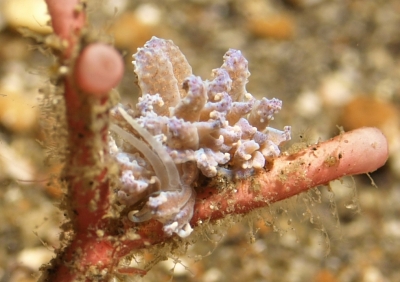
Concerning message #20423:
Hi Bill,
A friend of mine back from Indonesia showed me this slug, which I suppose is a Phyllodesmium but for the species ? P.crypticum or P. lembehensis??
Could you help us about the id ?
Locality: Lembeh, 8 m, Indonesia, Celebes Sea, 26 November 2008. Length: 20 mm. Photographer: Elisabeth Juan.
Many thanks and kind regards,
Dom.
dominique.horst@wanadoo.fr
Horst, D., 2009 (Jan 29) Phyllodesmium crypticum ? from Indonesia. [Message in] Sea Slug Forum. Australian Museum, Sydney. Available from http://www.seaslugforum.net/find/22190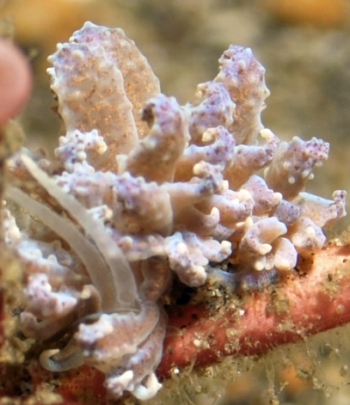
Dear Dom,
It's not that easy to separate some species of Phyllodesmium from a photo, but I suspect this is P. crypticum. In P. lembehensis the brownish zooxanthellae seem to be restricted to nodules along the edge of the cerata while your animal sems to have digestive gland branches running to the flat upper and lower surfaces as well.
Best wishes,
Bill Rudman
Phyllodesmium crypticum from sthn Queensland [2]
September 1, 2008
From: Gary Cobb
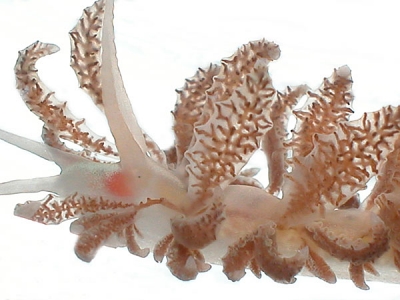
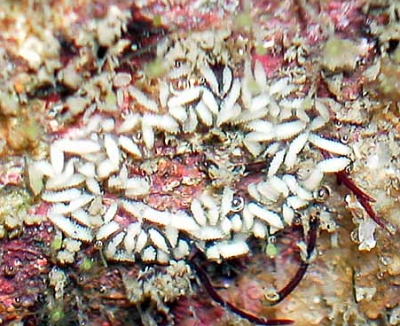
Bill,
To accompany my first message [#20422], here are a few more photos of Phyllodesmium crypticum, including one of its egg ribbon.
Locality: Alexandra Headland, 10-100 mm, Queensland, Australia, Pacific Ocean, 19 April 2004, Intertial and subtidal. Length: 5-55 mm. Photographer: Gary Cobb.
Cheers,
Gary Cobb
gary@nudibranch.com.au
Cobb, G.C., 2008 (Sep 1) Phyllodesmium crypticum from sthn Queensland [2]. [Message in] Sea Slug Forum. Australian Museum, Sydney. Available from http://www.seaslugforum.net/find/20423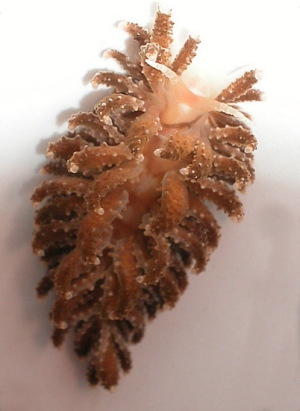
Thanks Gary,
The close-up of the cerata shows the secondary and tertiary branching of the digestive gland ducts very well.
Best wishes,
Bill Rudman
Phyllodesmium crypticum from sthn Queensland [1]
September 1, 2008
From: Gary Cobb
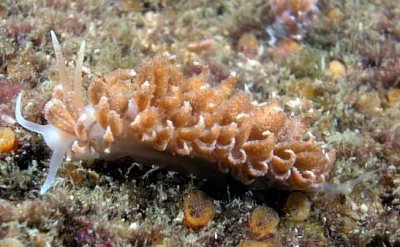
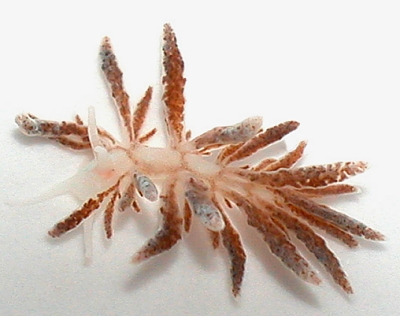
Hi Bill and everyone!
I see you mentioned Phyllodesmium crypticum. At Alexandra Headland intertidal area I have found many of these beautiful animals. Many egg masses too. You have to be very careful when handling this species ... it casts it's cerata at the slightest touch! In this message the animal shot on white is a 5 mm long juvenile.
Locality: Alexandra Headland, 10-100 mm , Queensland, Australia, Pacific Ocean, 19 April 2004, Intertial and subtidal. Length: 5-55 mm. Photographer: Gary Cobb.
See also Part 2 [#20423 ].
Cheers
Gary Cobb
gary@nudibranch.com.au
Cobb, G.C., 2008 (Sep 1) Phyllodesmium crypticum from sthn Queensland [1]. [Message in] Sea Slug Forum. Australian Museum, Sydney. Available from http://www.seaslugforum.net/find/20422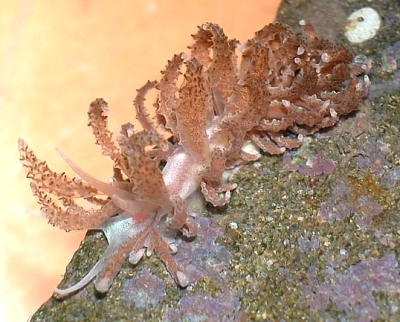
Thanks Gary,
Yes one of the problems of studying these animals is their tendency to drop off their cerata [see autotomy page]. Your photos, and the ones in the second message, show many of the characters of those species of Phyllodesmium which feed on xeniid soft corals. All of them restrict the secondary and tertiary branching of the digestive gland to the cerata, so the body wall is translucent white with only the main ducts of the digestive gland, leading from the stomach to the cerata, showing through the body wall as brown lines. By comparison, the new Phyllodesmium koehleri [see message #21841] has branches of the digestive gland throughout the body wall and even the rhinophores.
Best wishes,
Bill Rudman
Re: Chromodoris lochi from Indonesia
August 8, 2007
From: Ken Tucker
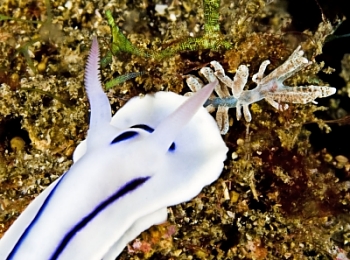
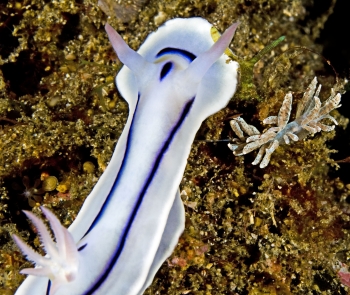
Concerning message #20402:
Yes, since you are interested, I have a sequence of 10 photos showing the two together, and their brief encounter. C. lochi moves across the field, eventually bumping into Phyllodesmium crypticum [first photo]. C. lochi "abruptly" changes direction, and continues on around. The second photo is perhaps a better photo if P. crypticum.
Locality: North Sulawesi, Lembeh Strait, 10 metres, Indonesia, Celebes Sea, 5 Nov 2005. Length: 2+ cm. Photographer: Ken Tucker.
Ken Tucker
ken@kilili.com
Tucker, K.C., 2007 (Aug 8) Re: Chromodoris lochi from Indonesia. [Message in] Sea Slug Forum. Australian Museum, Sydney. Available from http://www.seaslugforum.net/find/20415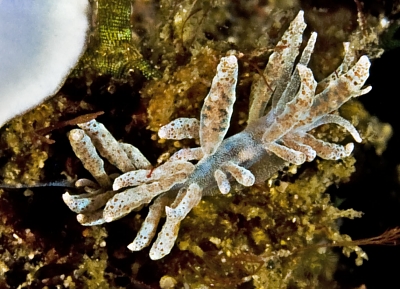
Thanks Ken,
Species of Phyllodesmium lack the cnidosac filled with stinging nematocysts at the tip of each ceras, which is the first line of defence for most aeolids, and instead have a large gland at the ceratal tip producing secretions apparently to deter potential predators. Perhaps that is what caused the avoidance action in your Chromodoris.
Best wishes,
Bill Rudman
Phyllodesmium crypticum from sthn Queensland
May 28, 2007
From: Bruce Wilkie
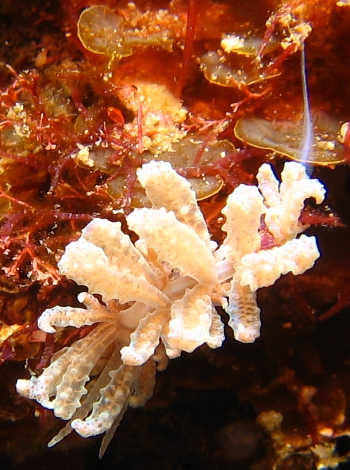
Hi Bill,
I found this animal the other day, and I think it may be Phyllodesmium crypticum, could you please confirm the id?
Locality: Flat Rock North Stradbroke Island, 16 metres, Queensland Australia, Pacific ocean, 24 February 2007, rocky reef with sponges, hard & soft corals . Length: 15mm. Photographer: Bruce Wilkie.
Many Thanks,
Bruce Wilkie.
brucedwilkie@yahoo.com.au
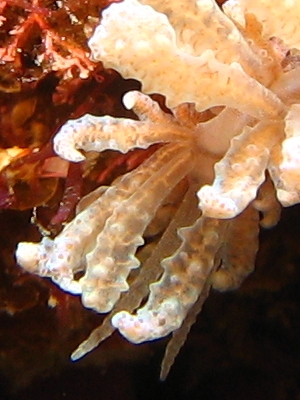
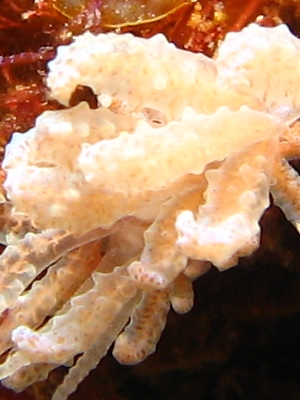
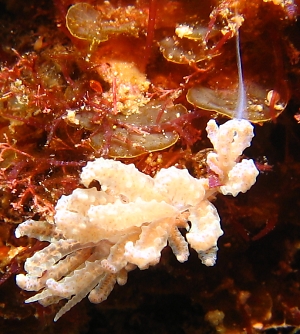
Dear Bruce,
Yes this is P. crypticum. I have added a couple of close-ups to show the branching of the digestive gland in the cerata. Your animal shows only a few scattered brown patches on the ceratal wall which suggests it is short of the unicellular algae [zooxanthellae] it gets from feeding on certain soft corals. I guess it hasn't fed for a while.
Best wishes,
Bill Rudman
Phyllodesmium crypticum from the Red Sea
April 16, 2005
From: Binyamin Koretz
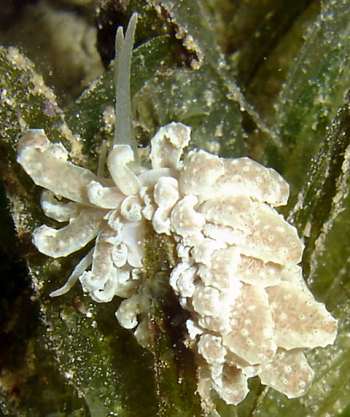
Hi Bill,
Another newcomer to Eilat: Phyllodesmium crypticum.
Locality: Eilat, Village Beach, Israel, Red Sea (Gulf of Eilat). Depth: 23 m. Length: ca. 4 cm. 02 April 2005. sea grass and patch reef. Photographer: Binyamin and Shulamit Koretz.
Best regards
Binyamin
binyamin@koretz.net
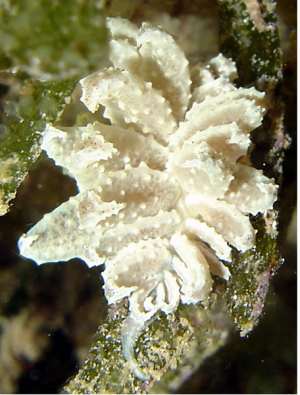
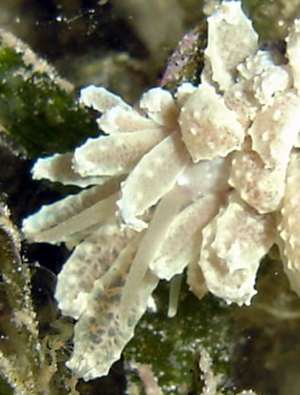
Dear Binyamin,
When I first saw your photos I wondered if you had a pale version of the sacoglossan Cyerce, but the branching of the digestive gland in the cerata [see lower right photo] are characteristic of P. crypticum. As far as I can recall this has not been found in the western Indian Ocean before - another interesting find.
Best wishes,
Bill Rudman
Phyllodesmium from Indonesia
March 24, 2003
From: Patricia Danna
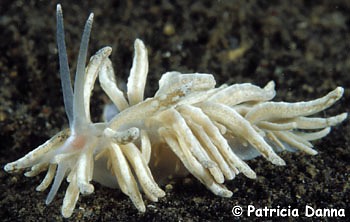
Dear Bill,
It looks very much like both Phyllodesmium hyalinum or P. crypticum .
Location: Lembeh Strait, Sulawesi, Indonesia. Depth: 12m
Length: 3 to 4cm
Date: November 2001. [#c30]
Thanks,
Pat
tdmpat@chez.com
Danna, P., 2003 (Mar 24) Phyllodesmium from Indonesia. [Message in] Sea Slug Forum. Australian Museum, Sydney. Available from http://www.seaslugforum.net/find/9139Dear Pat,
I think, like your other specimen, that this is P. crypticum, but it is pretty difficult to be sure just from a photo. I have listed some of the external differences on the Phyllodesmium hyalinum Fact Sheet but two of the important differences are difficult. The position of the anus, is only useful, if it can be seen in the photos, and whether te cerata are in single or double rows can be confused if the animal has dropped a lot of its cerata - a fairly normal defensive strategy. The distinctive 'edges' to the cerata and the relatively long rhinophores, make me think this is P. crypticum, but I can't more than about 75% sure.
Cheers,
Bill Rudman
Phyllodesmium from Indonesia
February 26, 2003
From: Pat. Danna
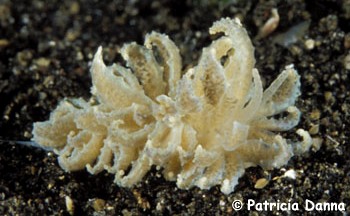
Dear Bill,
I'd be most grateful if you could help me identify this tiny nudibranch.
Photos: Lembeh Strait, Sulawesi, Indonesia. Depth 7m. Long 15 to 20mm. November 2001. [#c30]
Thanks for your help.
Pat. Danna
tdmpat@chez.com
Danna, P., 2003 (Feb 26) Phyllodesmium from Indonesia. [Message in] Sea Slug Forum. Australian Museum, Sydney. Available from http://www.seaslugforum.net/find/9138Dear Pat,
There are a number of species of Phyllodesmium which feed on the softcoral Xenia and look very like it. I am pretty sure this is Phyllodesmium crypticum.
Best wishes,
Bill Rudman
Phyllodesmium crypticum from Indonesia
December 19, 2002
From: Mary Jane Adams
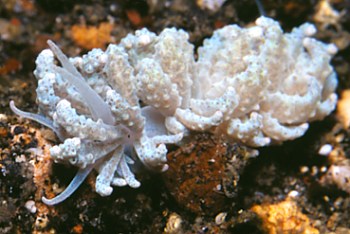
Hi Bill,
I can't figure this one out. I photographed it in Lembeh Strait, Sulawesi Island, Indonesia on Nov. 23, 2002. It was 15mm long.
Divesite: Hairball Too. Depth: about 15 meters.
Can you ID it for me?
Thanks!
Mary Jane
divepng@yahoo.com
Adams, MJ., 2002 (Dec 19) Phyllodesmium crypticum from Indonesia. [Message in] Sea Slug Forum. Australian Museum, Sydney. Available from http://www.seaslugforum.net/find/8650Dear Mary Jane,
I am pretty sure this is Phyllodesmium crypticum. Although I initially described this species from northern New South Wales in eastern Australia, later finds from Western Australia suggest it may have wide Indo-West Pacific distribution. It feeds on colonies of Xenia, and its knobbly cerata, make it very well camouflaged on its prey.
Best wishes,
Bill Rudman
Phyllodesmium crypticum from NW Australia
May 3, 1999
From: Clay Bryce
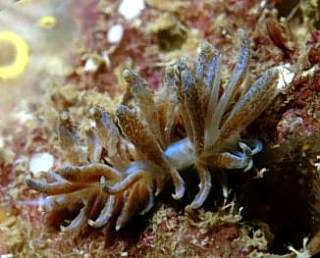
Bill,
Is this Phyllodesmium crypticum? I am unfamiliar with this animal and is the
first I have seen, if it is indeed P. crypticum? It is from the Dampier Archipelago.
Cheers,
Clay Bryce
brycec@museum.wa.gov.au
Bryce, C., 1999 (May 3) Phyllodesmium crypticum from NW Australia. [Message in] Sea Slug Forum. Australian Museum, Sydney. Available from http://www.seaslugforum.net/find/810Dear Clay,
I am pretty sure this is Phyllodesmium crypticum. I reported specimens of this species from the Dampier Archipelago in northwestern Australia from your museum collections in my 1991 paper. Before that it was only known from eastern Australia.
Bill Rudman.
